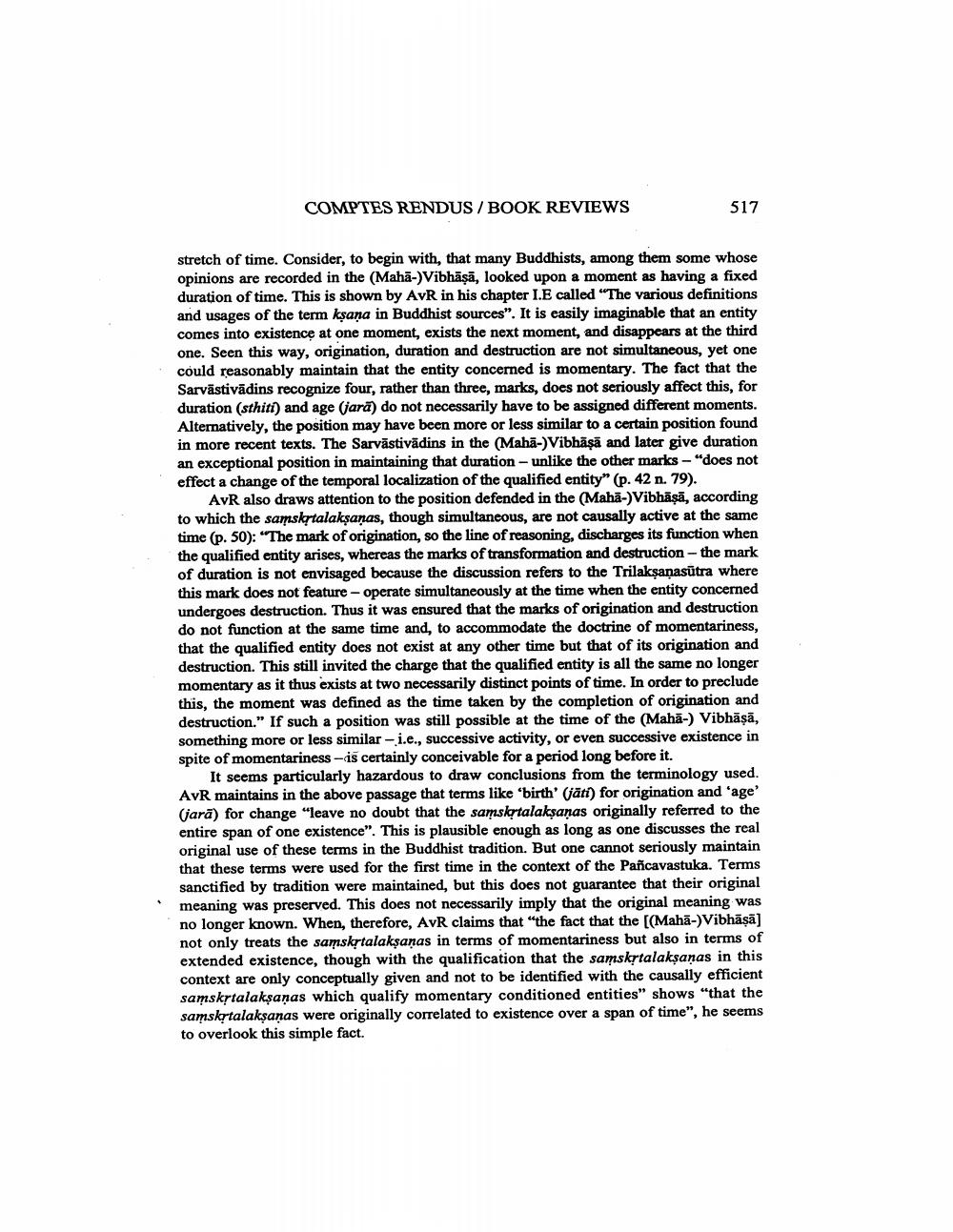Book Title: Buchbesprechungen Comptes Rendus Book Reviews Author(s): Peter Schreiner Publisher: Peter Schreiner View full book textPage 5
________________ COMPTES RENDUS / BOOK REVIEWS 517 stretch of time. Consider, to begin with, that many Buddhists, among them some whose opinions are recorded in the (Mahā-)Vibhāṣā, looked upon a moment as having a fixed duration of time. This is shown by AVR in his chapter I.E called "The various definitions and usages of the term kşana in Buddhist sources". It is easily imaginable that an entity comes into existence at one moment, exists the next moment, and disappears at the third one. Seen this way, origination, duration and destruction are not simultaneous, yet one could reasonably maintain that the entity concerned is momentary. The fact that the Sarvāstivādins recognize four, rather than three, marks, does not seriously affect this, for duration (sthiti) and age (jara) do not necessarily have to be assigned different moments. Alternatively, the position may have been more or less similar to a certain position found in more recent texts. The Sarvāstivādins in the (Mahā-) Vibhāşā and later give duration an exceptional position in maintaining that duration - unlike the other marks - "does not effect a change of the temporal localization of the qualified entity" (p. 42 n. 79). AVR also draws attention to the position defended in the (Mahā-) Vibhāsā, according to which the samsktalaksanas, though simultaneous, are not causally active at the same time (p. 50): "The mark of origination, so the line of reasoning, discharges its function when the qualified entity arises, whereas the marks of transformation and destruction - the mark of duration is not envisaged because the discussion refers to the Trilaksanasūtra where this mark does not feature - operate simultaneously at the time when the entity concerned undergoes destruction. Thus it was ensured that the marks of origination and destruction do not function at the same time and, to accommodate the doctrine of momentariness, that the qualified entity does not exist at any other time but that of its origination and destruction. This still invited the charge that the qualified entity is all the same no longer momentary as it thus exists at two necessarily distinct points of time. In order to preclude this, the moment was defined as the time taken by the completion of origination and destruction." If such a position was still possible at the time of the (Mahā-) Vibhāṣā, something more or less similar - i.e., successive activity, or even successive existence in spite of momentariness-is certainly conceivable for a period long before it. It seems particularly hazardous to draw conclusions from the terminology used. AVR maintains in the above passage that terms like 'birth' (jāti) for origination and 'age' (jarā) for change "leave no doubt that the samsktalaksanas originally referred to the entire span of one existence". This is plausible enough as long as one discusses the real original use of these terms in the Buddhist tradition. But one cannot seriously maintain that these terms were used for the first time in the context of the Pancavastuka. Terms sanctified by tradition were maintained, but this does not guarantee that their original meaning was preserved. This does not necessarily imply that the original meaning was no longer known. When, therefore, AvR claims that "the fact that the [(Mahā-)Vibhāṣā] not only treats the samskýtalakşanas in terms of momentariness but also in terms of extended existence, though with the qualification that the samskytalaksanas in this context are only conceptually given and not to be identified with the causally efficient samskýtalaksaņas which qualify momentary conditioned entities" shows that the samskrtalaksanas were originally correlated to existence over a span of time", he seems to overlook this simple fact.Page Navigation
1 ... 3 4 5 6 7 8
